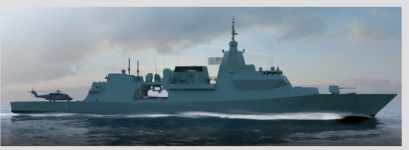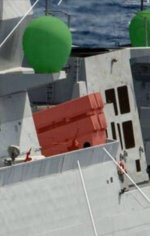Careful consideration: Positioning the next Canadian Frigates for the Fights of the Future
The process to choose the winning design for the Canadian Surface Combatant (CSC) is well underway, with the final selection expected sometime this year. We don’t know much about the exact requirements for the CSC but the Royal Canadian Navy’s (RCN) flagship strategy document, Leadmark 2050 , is clear: while the CSC will undertake a variety of mission types, it will be designed primarily to operate in a high-end warfighting environment. That makes sense since a ship designed to fight pirates and provide disaster relief wouldn’t fare well against modern anti-ship cruise missiles or torpedoes.
Operating in a high-end environment requires a combat management system (CMS) that tightly integrates the ship’s weapons, sensors, communications and data links to allow it to defend itself and take the fight to the enemy. This is especially true for air defence, as the nature of contemporary air threats means that the crew often has minutes (or seconds if the threat is supersonic) to react to a missile that comes over the horizon. The CMS is key in this situation, as it can gather and display data from the ship’s sensors, activate kinetic or non-kinetic countermeasures, and cue incoming threats much faster than a human can.
There are three broad categories of air defence capabilities that the government should consider (and prioritize) when deciding on the CSC’s CMS/design: short- to medium-range; long-range; and ballistic missile defence (BMD). Having an effective short- to medium-range air defence capability is perhaps the most important in terms of ship survivability and should be prioritized. But being able to detect and engage threats at longer ranges will likely become almost as important as threats become more advanced and the CSC becomes responsible for the air defence of deployed land forces. So, decisions made on the CMS now will likely have long-term effects down the road.
Missiles such as the Evolved Sea Sparrow Missile (ESSM) and the Aster 15, with ranges of around 50 kilometres, will likely form the core of the CSC’s short-to medium-range air defence capability, so having a CMS that works with them will likely be critical. Both Lockheed Martin Canada’s CMS330—the CMS on the Halifax-class frigates—and Atlas Elektronik’s ANCS CMS are already integrated with ESSM. So is 9LV, the CMS offered by Navantia and SAAB Australia in their bid, which is currently serving on a number of Australian naval vessels. The combination of 9LV, Australia’s CEAFAR radar, and ESSM on Australia’s ANZAC-class frigates is assessed by some defence analysts to be the best short- to medium-range naval air defence system in the world. Interestingly, CMS330 is also in the process of being integrated with MBDA’s new Sea Ceptor short-range air defence missile on New Zealand’s ANZAC-class frigates.
In terms of providing a long-range air defence, things get more complicated. Two of three systems on offer (CMS330 and 9LV) have not yet been integrated with a long-range air defence missile system like SM-2 or SM-6, missiles with ranges of over 150 kilometres. That fact is more of an indictment on the CAF’s requirements than on the systems themselves; but it’s strange that there may be no requirement for such a capability right off the bat, given the growing importance of long-range air defence in both the ship and area defence roles the government has stated the CSC will fulfill. That’s not to say longer-ranged missile systems cannot be integrated into 9LV and CMS330 in the future—quite the opposite in fact, given their modularity—but they’re not integrated “off-the-shelf” like they are in ANCS. Systems integration is a complex process and additional integration increases the risk of cost overruns and delays.
The Australian Future Frigate faces the same problem. Australia’s solution was to “combine” (in some manner) the 9LV/CEAFAR radar combination with the US Navy’s (USN) Aegis CMS to facilitate the integration of future US missile systems such as the SM-6 to give the Future Frigate greater long-range air defence capabilities. By “combining” 9LV/CEAFAR and Aegis, Australia is hedging the future viability of its Future Frigates on the continued ability of the USN to be on the cutting edge of naval weapons and sensors technology. Having Aegis on its ships alleviates the Royal Australian Navy of the burden (and cost) of integrating new American weapons systems and sensors into its own CMS architecture. It’s unclear as to whether Navantia and SAAB Australia are offering the 9LV/Aegis CMS combination in their CSC bid, although the CEAFAR radar is included.
The Canadian government must think carefully about its approach to ‘futureproofing’ the CSC to ensure that the ships can be upgraded as effectively and cost-efficiently as possible in the future. If Aegis is included in the Navantia/SAAB Australia bid and is selected, Canada would be able lessen future integration costs through collaboration with the US and Australia. If Aegis isn’t included, then Canada would likely be responsible for integrating future weapons systems and sensors into its CMS architecture no matter which CMS is chosen. That approach increases the risk of delays and cost overruns down the road. Now Canada doesn’t have to go down the same route as Australia to “futureproof”, it could instead choose to install a European “family” of weapons and sensors on the CSC to lessen the future acquisition costs.
Another potential aspect of ‘futureproofing’ is ballistic missile defence (BMD). Currently, the US and Japan are the only countries with an effective sea-based capability to track and engage theatre ballistic missiles using a special configuration of the Aegis CMS and the SM-3 missile. Dutch De Zeven Provinciën-class frigates—the design on which Alion Science and Technology/Damen Shipbuilding’s bid is based—have demonstrated the ability to track ballistic missiles but lack the ability to engage them, and other countries are incorporating BMD into their future ships. Should the RCN need such a capability, it’s likely that many of the future weapons and sensors installed on the CSC will have some inherent ability to conduct BMD. However, none of the CMSs offered have the ability to do so “off-the-shelf” and integrating such a capability would entail additional costs and trade-offs in terms of potential mission loadouts.
Given the nature of threats the CSC is likely to face in the future, careful deliberation is needed when deciding which CMS best meets the CAF’s short- and long-term requirements. The risk profile of each CMS on offer is likely to be an important factor in positioning the CSC for future upgrades. None of the options are risk-free, but good planning should ensure that Canada is able to field an effective, upgradeable CSC that can fulfill the government’s requirements now and in the future.
Disclosure: Lockheed Martin Canada is a corporate sponsor of the CDA Institute.
Christopher Cowan is a Research Analyst and Editor at the CDA Institute.






